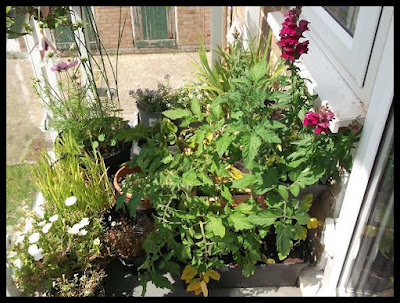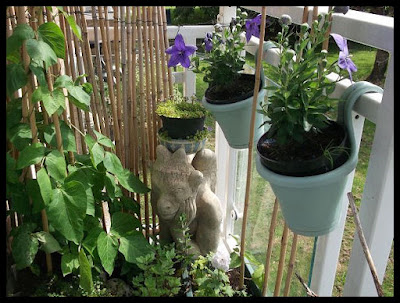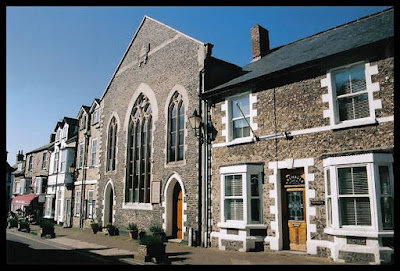This is a village with the most amazing variety of architectural styles, many of which are late 19th and early 20th century Arts & Crafts buildings, along with the much older vernacular cottages and parish church.
I've taken photos of Fore Street buildings on several different occasions and I still haven't quite got everything! A long winding street down to the sea front with a stream running down one side, crossing over to the other side towards the end. As I wrote in my article about the stream and its conduits, the name of the village Beer comes from the Anglo-Saxon word Bearu, which means 'grove' as Beer was once surrounded by woods, and nothing to do with the alcoholic beverage! ;)
Several
of these buildings have pages of their own, so I'm just giving some
sketchy details of those, along with the link for the articles containing more
information and photos.
Starting at the Square - at the top of Fore Street - the first conduit, photo above, is on the corner with Fore Street and the Causeway and is right outside the delightful thatched Shepherd's Cottage, which was originally two separate cottages made into one.
Dated to circa late 17th or early 18th century, it's a Grade II listed building, more of which can be read about here. There's also an article about the two conduits and stream, here.
The name Fore Street is the Devon equivalent of High Street in small towns and villages, although in cities it's usually the forerunning street leading up to the High Street, as can be found in Exeter, which is the county town* of Devon.
*County Town being the capital city in the county.
Next door is a cottage attached to Durham House Hotel, Durham House being the first of the Arts & Crafts revival buildings.
This wonderfully higgledy piggledy building is dated 1897, with a facade of Beer Stone from the local quarry situated above the village. Including gorgeous stained glass windows, a tiled hallway of Minton ceramics with some lovely Victorian Gothic features, it's an absolute delight.
More can be seen here.
And then we have Colebrook House next door to that. Like Durham House, it isn't a listed building, but it nevertheless has its own fabulous Arts and Crafts style and is also sharing the same continuous roof line.
Some of the buildings on Fore Street have been attributed to the architect David Carr, who lived in Beer and worked for the Clinton Devon Estates. I suspect that he designed more than was credited for, as they have the most wonderful features different to - yet nonetheless akin to - his style, including these two buildings.
Like Durham House, it
isn't a listed building, but it nevertheless has its own fabulous Arts
and Crafts style and is also sharing the same continuous roof line.
The entrance can be seen below, situated on the corner with a fab tiny window with drip mould above. The corner stone has been moulded into shapes above that, which is rather unusual.
More about Colebrook House can be seen here.
And a photo looking back along the street, below, showing Colebrook House and Durham House on the far right.
After this are a few buildings that I missed out, including the building on the left of the above photo, and all of them in that same style. However, the following one after those is the wonderfully quirky Steam Gallery with its slightly wonky chimney above the corner entrance.
Now this one was accredited to the architect David Carr, and similarity to Colebrook House can be seen in the corner entrance. Other features can also be seen on various other non-attributed buildings, such as the cute mullion windows above the large shop ones and its off-centred nature.
That's another one which can be seen on its own article along with the Marine Gallery here.
I missed out the following three buildings before the next entrance way, then opposite the parish church of St Michael is this delightful building with three gables, containing three separate occupancies including the central Gina's Restaurant.
I don't have any information about this one but it comprises three floors and has a lovely Edwardian style balcony running along the first floor of all three residencies. The second floor contains windows in each gable on the steep pitched roof. The top floors might belong to the shops on the ground floor, or are possibly self-contained flats - and they could also be rented out as holiday flats.
And outside this is the second Conduit, seen below with the stream looking back up the street.
This next cottge along reminds me of the iconic childhood drawing of what a house should look like; a central door with a window each side and windows above those on the first floor.
Interesting canted window bays on the ground floor with sash windows above, the door, seen below, is really lovely with a panel of leaded glass containing a fab compass design and the house name Valhalla in the fanlight above.
Constructed with local stone and flint rubble with brilliant white quoins, door and
window surrounds, it's attached to - and looks similar to - the
Congregational Church next door. It's one of several which has the intention of fitting in with the surrounding styles.
The church, of course, is next.
Opened
in 1856, it has been enlarged twice for growing congregations, once in
1880 then again in 1920. As it isn't a listed building there's not much
information. However there are some snippets of interest, as well as
interior photos complete with decorations for the annual Fisherman's Harvest of the Sea festival in the full article, which can be seen here.
This is followed by a terrace consisting of five bays. The first one by the church is the former Congregational Hall, then to the left is the White House Cafe, which is also a fish & Chip shop. Built circa late 18th to early 19th century, they are listed Grade II buildings.
Each section consists of two gabled attic dormers on the roof with the inbetween bay containing the door for the hall and a canted oriel window on the first floor. Attractive string courses run across each ground storey and first floors beneath the windowsills.
And next along is the delightful Woozi's Deli.
Called the Diamond House in the Listed Building entry, it's a Grade II building comprising a three storey house with shop premises on the ground floor.
Quite different to others along Fore Street, this early 19th century building is chequered with an ashlar and knapped flint decoration. Quoins on the sides of the front match the rusticated window surrounds on the second floor. Two diamond shapes sit in the centre of each of the top floors, which can be seen a bit closer below.
I don't know what those small metal pieces are beneath the bottom diamond but the central one directly beneath is something that's seen outside many shops in East Devon. They're for small christmas trees; the pipes are angled so that the tree trunk fits inside the pipe and sticks out obliquely. Festooned with lights, they look fabulous against the long winter nights.
And the last one on this stretch before the turning into Clapps Lane is Pegasus Cottage, above on the left.
I haven't been able to discover anything about this building and it isn't on the Listed Buildings Register either. A two bay of different levels at the front gives it that higgledy piggledy look, especially with the entrance tucked in the corner between them.A bas relief of pegasus is depicted on the wall between the two first floor windows on the side elevation. The windows have wrought or cast iron window guards, which were prevalent in Regency buildings, but may have been used later for this building. Another one can be seen on the ground floor to the left, with a lovely tiny garden in front, seen below.
If I can revisit I'll take more photos of this as there are more interesting features and may well deserve an article of its own. :)
As you can see I decided to put this post in more than one part, as there's too much to include in one go. So, I'm leaving it here at the moment. There are still a few more buildings on this side of Fore Street, but not many photographed on the other, so the two sections will make a decent second part. However, if I manage to get over there and take more photos it might be split three ways instead!
Having looked more closely at everything - Google Street View is one of my best friends! - I'm tempted to write stand alone articles of more buildings too. If so, I'll add the links to this post.
So, there we go! I'm all fired up for returning so I'll do my best. Meanwhile I've taken photos of the delicious Arts and Crafts houses & bungalows nearby my road and will be scanning those as soon as they're processed.
Cheers for now. :)



























































